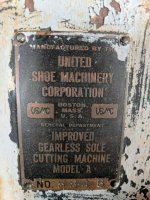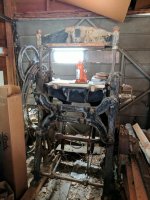About thirty years ago, I was asked to have a look at dismantling and getting a complete boot and shoe manufacturing plant down a couple of stairs, This plant was quite comprehensive and was capable of manufacturing boot's and shoes in a fair quantity, It was part of the works department of a large hospital for the insane, and rthe whole complex was designed in its day to be self sufficient, and also give work to many of the inmates I cannot recall the actual manufacturers of the machinery, but The united boot and Shoe Co rings a bell,
Sadly this venture came to nothing as far as I can recollect and a few years later the hooligans broke in and torched a lovely building, I always thought as times had moved on and more humane treatment methods were being instigated for these souls, previously locked up and out of sight for decades, a similar duty of care could have been to save and reuse an extremely fine building, So big was this institution that at one period in times past this hospital even had there own steam locomotive to transport in wagons of coal and produce from a local railway siding Should one ever read the book by A.J. Cronin, entitled Hatters Castle , It was based around the said institution in which the writer was a doctor at some period during his medical career He also penned his very famous book "The Stars Look Down" which talks of the hardship and struggle of the Scottish Fife miners.
At one stage I also visited a small two man band boot making concern in Glasgow and the two owners working it had a pretty dodgy looking machine to operate This was a belt driven press consisting of a flat platten upon which one placed a sheet of heavy leather, placed on top of the material sharp edged formers of the shape of the sole one desired , brought down the top plattewn, and bingo, one had the desired pressingas, " Some spare fingers anyone?" todays Health and Safety Guru's would have kittens
At one stage in Scotlands past industrial greatness The Ayrshire town of Maybole was a very large centre of the manufacture of boots and shoes, this centre of excellence had from memory about five ? large factories So prolific was the production rates that every day two train loads of produce left the town I am interested in Ted's post the English boot and shoe trade was an extremely large employer of labour and by the sound of things The United boot and Shoe company's works no doubt one of many firms keeping the show on the road , along with the leather production firms all over the U.K. Scotland had many famous firms in that sphere also, nowadays one purchases a pair of shoes and a fortnight later ones feet are getting "Swimming Lessons " In the past years had todays firms turned up with their crap products, The workers and citizens would have given them short shrift Further modenity doesnt always equate to quality.









 .
.